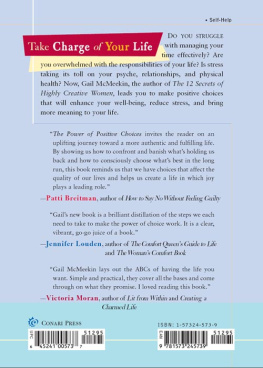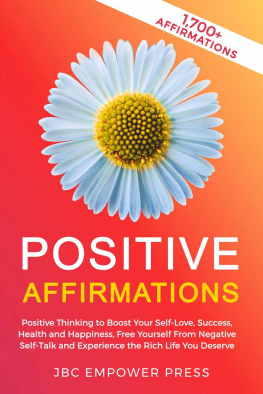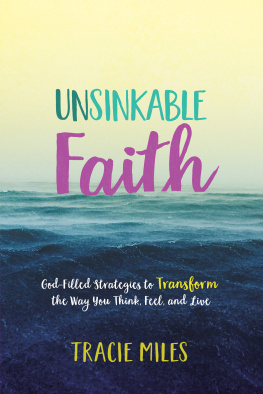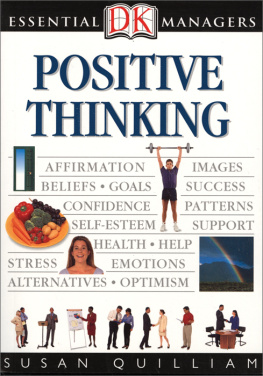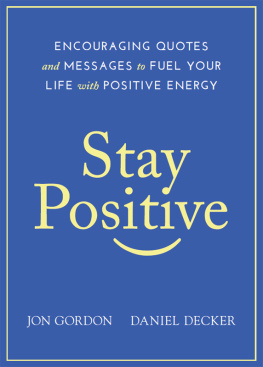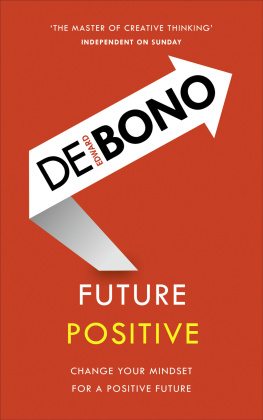Foreword
This book does not provide advice for any mental or physical health issue. It supports you in taking conscious steps to reprogram your thoughts and emotions towards choosing a positive approach to life.
You can re-train your brain and let go of old destructive habits and beliefs, whether you have formed them yourself or found them imposed on you by someone else. Life is not predictable and sometimes we cant choose what happens to us, yet how we respond to challenges, set-backs, successes and joys, is under our influence.
The strategies offered in this book to release unhelpful thoughts and feelings require your active involvement. They have been compiled from working in private practice in counselling and hypnotherapy over a fifteen year period. A dedicated approach will bring the strongest benefits, yet each activity is straightforward and able to be completed in the quiet time you have available to yourself.
Please seek advice from a medical practitioner if you are experiencing very low mood, high anxiety or any thoughts of self-harm. This book is no substitute for required professional treatment.
Michelle Robinson
The Mind-Body Connection
The importance of the mind-body connection in creating health is well documented by ancient cultures as well as contemporary authors. Today this idea is often expressed in the simple statement, You are what you think.
It is tempting to dismiss this concept, because it sounds too easy to say, perhaps even a little condescending, if spoken by someone offering advice. However, the key message of this book is that whom we become does significantly depend on what we think.
Neuroscience now understands that our thoughts and emotions guide the creation of our neural pathways. Neural pathways are like the circuits or road-maps in our brain that drive our behaviour, beliefs and habits. Within us, chemicals and electrical impulses respond to the thoughts and emotions we experience in every moment. These thoughts and emotions produce tiny, interwoven, branch-like structures in the brain. These in turn create our neural pathways.
Strong thoughts and emotions, especially if experienced frequently, create long lasting neural pathways that guide us towards responding in the same or similar ways each time. This means it is easy to continually repeat emotional and behavioural patterns from the past.
If we are triggered to anger whenever we feel the world is unfair, then anger becomes an automatic response. If we practise tolerance because we choose to feel positive about others and our self, then this becomes our default.
It is as though we continue to follow a road that we have always taken, regardless of whether this helps or limits us. Other roads may be available that would suit us better, but we stick with familiar choices.
It is true that we cannot control everything that happens in our life; however, we can choose how to respond. We can learn to respond with flexible, positive behaviours and break limiting conditioning.
Inability to let go of past hurts, repeating unwise choices, feeling stuck in unhelpful habits, chronically low self- esteem, anxiety, anger and depression - these are some of our internal sign-posts that tell us unhelpful, automatic responses are running our life, and unfortunately, our health pays the price.
Very high levels of stress, such as from repressed anger, guilt, grief, resentment, fatigue, anxiety, poor self-care and so on, harm us. They put pressure on our immune, autonomic and muscular skeletal systems, right down to cellular regeneration. Stressful emotions also compromise our emotional and mental health.
Positive emotions help us heal; they align us with well-being and optimism. They support cellular regeneration, a strong immune system, a healthy heart and the maintenance of a balanced physical, emotional and mental state.
This is easy to understand when we remember that each of us is an energetic being.
Although you appear solid, you are a swirling, flowing energy-mass comprised of billions of subatomic particles. There is far more space within you than matter, and so rather than ageing in a fixed, predictable way, you evolve in every moment, renewing the cells in your organs, bones, blood, muscles and tissues.
You do this, even though you do not understand how. Below your awareness, a wise inner healer strives always to connect you with your blue-print for health.
You can support this process. By choosing positive thoughts, feelings, habits and beliefs, you can create stronger health and a balanced perspective. This is the focus of the book.
Whether you are already practising positivity or feel a call to makes some changes, the information and strategies in the following pages are intended to help you create more self-awareness, flexibility of choices and well-being.
Red Flags for Healthy Thinking
Each of the following statements is a red flag to alert you to sabotaging or unhelpful thoughts. Reflect on whether any of these, or similar thoughts and feelings, influence your life.
Relationship with Myself
- I expect to fail at something before I begin.
- I dislike looking in the mirror.
- I have a critical voice in my head that keeps sabotaging me.
- I feel depressed, anxious, unable to get motivated.
- I have little self-confidence and self-worth.
- I feel guilty and blame myself for things that have happened.
- I feel lost and dont know how to feel happy.
Relationships with Others
- I am still very angry at one or more people from my past.
- I am self-conscious and embarrassed in social and work settings.
- I doubt whether my family/friends/partner really like or love me. Maybe they are just being polite/feel sorry for me.
- I give more to others than I receive. I often feel hurt and let down.
- I cant forgive myself for relationships that have failed.
- I find it hard to trust people and make new friends.
Repeated Patterns
- I cant believe how I keep making the same mistakes.
- I sabotage myself. I quit even when I want to do something.
- I befriend people who seem to need my help and I always end up hurt.
- I keep losing money/assets/relationships because of poor decisions or behaviour.
- I sometimes put myself in harms way and regret it later.
- I sabotage my relationships but cant seem to change.
- I sacrifice my well-being for others and then I feel resentful.
- I have an addiction or a habit I struggle to control.
- I stuff my feelings down. I cant express what matters to me.
You will notice that none of the statements above expand your confidence or personal growth. The opposite is true.
Our decisions are generally based on what we are thinking and feeling, and what we think and feel forms our beliefs.
Here is an example.
If I think that I am capable of performing a higher role at work and feel confident in my abilities, then I believe success is possible. I also believe I am worthy of a promotion. I will take the steps required to apply for the role I desire.
If I tell myself that I am slow to learn new skills and feel like everyone else is smarter than I am, then I believe failure is likely. I am unwilling to apply for roles that might make me happier and believe I am destined to stay stuck in the same job.
Our thoughts, feelings and beliefs interact below the level of our awareness to drive our decisions and habits. Just as unhelpful neural pathways are formed through repetitive thoughts, feelings and behaviours, our positive responses have been formed in the same way. Hence, choosing positivity is the gift we could wisely offer our self.




